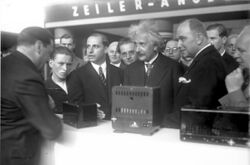Engineering:Internationale Funkausstellung Berlin
The IFA or Internationale Funkausstellung Berlin (International radio exhibition Berlin, a.k.a. 'Berlin Radio Show') is one of the oldest industrial exhibitions in Germany. Between 1924 and 1939 it was an annual event, but as from 1950 it was organized on a two yearly basis until 2005. Since then it has become an annual event again, held in September. Today it is one of world's leading trade shows for consumer electronics and home appliances.
It offers the opportunity to exhibitors to present their latest products and developments to the general public. As a result of daily reporting in almost all the German media, the radio exhibition achieves a large spreading of the information – and advertising messages and has also become international. In the course of its history, a large number of world innovations were first seen at the exhibition.[1]
(As of 2015) IFA is “Europe’s biggest tech show”.[2] 245,000 visitors and 1,645 exhibitors attended IFA 2015.[3]
History

German physicist and inventor Manfred von Ardenne gave a public demonstration of a television system using a cathode ray tube for both transmission (using flying-spot image scans, not a camera) and reception, at the 1931 show.[4]
In 1933 The Volksempfänger (VE 301 W),[5] a Nazi-sponsored radio receiver design, was introduced. Ordered by Dr. Joseph Goebbels, designed by Otto Griessing, sold by Gustav Seibt, it was presented at the tenth Berliner Funkausstellung on 18 August 1933,[6] its price fixed at 76 Reichsmark (RM). 100,000 units were sold during the exhibition.
In 1938 the DKE 38 (Deutscher Kleinempfänger 38, i.e. German miniature receiver 1938) followed, the price fixed at 35 RM.
AEG, founded in 1883 by Emil Rathenau, showed the first practical audio tape recorder, the Magnetophon K1, at the August 1935 show.[7][8]
In 1939 the exhibition was called Grosse Deutsche Funk- und Fernseh-Ausstellung (Great German Radio and Television Exhibition). The Einheits-Fernseh-Empfänger E1, a TV set designed to be affordable for everybody, was introduced. Plans for large-scale manufacture were thwarted by the outbreak of World War II. Color TV was also introduced (a prototype), based on an invention by Werner Flechsig (cf. shadow mask).
Multinational Dutch electronics corporation Philips introduced the compact audio cassette medium for audio storage and the first cassette recorder (the Philips EL3300), developed by ir. Lou Ottens and his team at the Philips factory in Hasselt, at the 1963 show, on Friday 30 August.[9][10]
Notes
- ↑ "Gramophone, Issue November 1989". Gramophone: 206. November 1989. http://www.gramophone.net/Issue/Page/November%201989/206/766604/. Retrieved 4 August 2010.
- ↑ Staff, Verge (7 September 2015). "IFA 2015: the best of Europe's biggest tech show". https://www.theverge.com/2015/9/2/9248209/ifa-2015-the-best-of-europes-biggest-tech-show.
- ↑ "Mehr Besucher und bessere Geschäfte bei der IFA". http://www.rbb-online.de/wirtschaft/thema/2015/ifa-berlin-2015/beitraege/mehr-besucher-und-bessere-geschaefte-bei-der-ifa.html.
- ↑ Albert Abramson, Zworykin: Pioneer of Television, University of Illinois Press, 1995, p. 111.
- ↑ VE=Volksempfänger; 301 = 30 January; W = Wechselstrom (=alternating current))
- ↑ "Goebbel's speech". Calvin.edu. 1933-08-18. http://www.calvin.edu/academic/cas/gpa/goeb56.htm. Retrieved 2013-09-13.
- ↑ History Department at the University of San Diego. "Magnetic Recording History Pictures". Archived from the original on 20 July 2009. https://web.archive.org/web/20090720111326/http://history.sandiego.edu/gen/recording/tape.html.
- ↑ "1935 AEG Magnetophon Tape Recorder". mixonline.com. 1 September 2006. Archived from the original on 8 February 2013. https://web.archive.org/web/20130208162634/http://mixonline.com/TECnology-Hall-of-Fame/aeg-magnetophone-recorder-090106/. Retrieved 18 June 2010.
- ↑ Schellinx, Harold (23 March 2013). "Mourning and Celebrating 50 years of Compact Cassette". SoundBlog. HarSMedia.com. http://www.harsmedia.com/SoundBlog/Archief/00793.php. Retrieved 25 August 2013.
- ↑ Rewound. On its 50th birthday, the cassette tape is still rolling. Time Magazine, 12 August 2013, p. 56–57
External links








